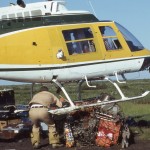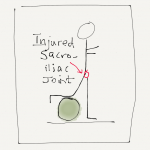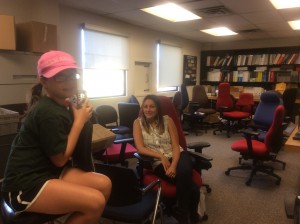 UPDATED 25 July 2015. It's been 7 weeks since I originally posted this blog. In the interim, it's been a case of 2 steps forward, one step back. I've acquired a file with the York University Human Resources Health, Safety and a personal trainer. I've also been back to my family doctor (the umbrella/gatekeeper for institutional reporting on injury-related issues) and she got me to participate in www.isaec.org, the provincially supported "Inter-professional Spine Assessment and Education Clinics" where I learned the appalling statistic, that about 70% of North Americans experience back pain that interferes with their everyday lives, and that these back problems and pain recur in 98% of that 70% of folk. I also learned that my back injury which comprises multiple symptoms relating to beyond the SI joint, to include the lower back, is almost certainly related to my car being rear-ended on the way home from the lab last November. I didn't think I was injured in any way. It took 5 months and the repetitive strain from driving in endless traffic and bending and twisting in the research greenhouse to interact with the original damage to my left pelvic lumbar region. Talk about delayed effect.
UPDATED 25 July 2015. It's been 7 weeks since I originally posted this blog. In the interim, it's been a case of 2 steps forward, one step back. I've acquired a file with the York University Human Resources Health, Safety and a personal trainer. I've also been back to my family doctor (the umbrella/gatekeeper for institutional reporting on injury-related issues) and she got me to participate in www.isaec.org, the provincially supported "Inter-professional Spine Assessment and Education Clinics" where I learned the appalling statistic, that about 70% of North Americans experience back pain that interferes with their everyday lives, and that these back problems and pain recur in 98% of that 70% of folk. I also learned that my back injury which comprises multiple symptoms relating to beyond the SI joint, to include the lower back, is almost certainly related to my car being rear-ended on the way home from the lab last November. I didn't think I was injured in any way. It took 5 months and the repetitive strain from driving in endless traffic and bending and twisting in the research greenhouse to interact with the original damage to my left pelvic lumbar region. Talk about delayed effect.
My goal is to get back to my non-injury level of activity, and to be in that 2%. I am much more mobile, but I still can't sit or drive for more than 30 minutes at a time without resting and doing lots of my physio exercises. If you were on the 401 Highway near Cambridge, Ontario on the Saturday morning of the the first day of the PanAm Games, I was that weird person doing sun salutations and bridges in the service centre parking lot.
One of the litmus tests of recovery included flying to Regina for the Public Engagement and the Politics of Evidence conference (July 23-25, 2015). A huge thanks a delightful Westjet crew member who allowed me to stand at the back of the plane for 40 minutes during that 3 hour flight and stretch. BACK TO THE ORIGINAL BLOG FROM June 4, 2015:
I am an unusual field ecologist in a lot of ways, but here, I refer to my injury-free career (to this point). By our mid-50s, many field biologists have suffered some kind of traumatic injury. I met my future husband in 1984, shortly after he had survived falling off a cliff in Shetland while doing his doctoral field work on sea birds. I must have reckoned that anyone that tough would have good genes!
 In the course of doing field work, backs are wrecked by hauling outboard motors and heavy equipment, and knees are wrecked from tripping over tree stumps in the forest etc. etc. I have moved gingerly and cautiously through many potentially treacherous landscapes over the last 35 years. I have carefully avoided coming into the line of fire of shotguns and rifles being carried for polar bear defence, spending too much time in choppers, falling off foggy cliffs, and being head butted by angry rams. I have managed to drive the very dangerous 401 highway to my field sites for nearly 20 years, without having an accident (NOT the case for friends of mine). Irony of ironies, then, to get injured doing urban ecology fieldwork, as a result of the cumulative effects of sitting for many hours in Toronto and Southern Ontario gridlocked traffic in a standard drive car, putting in the clutch from 1st to 3rd gear (rarely 4th-5th) and of twisting and stretching to reach greenhouse plants destined for Toronto gardens.
In the course of doing field work, backs are wrecked by hauling outboard motors and heavy equipment, and knees are wrecked from tripping over tree stumps in the forest etc. etc. I have moved gingerly and cautiously through many potentially treacherous landscapes over the last 35 years. I have carefully avoided coming into the line of fire of shotguns and rifles being carried for polar bear defence, spending too much time in choppers, falling off foggy cliffs, and being head butted by angry rams. I have managed to drive the very dangerous 401 highway to my field sites for nearly 20 years, without having an accident (NOT the case for friends of mine). Irony of ironies, then, to get injured doing urban ecology fieldwork, as a result of the cumulative effects of sitting for many hours in Toronto and Southern Ontario gridlocked traffic in a standard drive car, putting in the clutch from 1st to 3rd gear (rarely 4th-5th) and of twisting and stretching to reach greenhouse plants destined for Toronto gardens.
@dawnbazely I sometimes think traffic is a big reason so many people in Toronto seem so grumpy
— Melonie Fullick (@qui_oui) May 30, 2015
 I am late with posting this blog because, in the last 2 days, when not with a physiotherapist or registered massage therapist, or doing my new exercises, I was in pain and was resting on a magic Korean IR heat pad, watching Netflix (Bones Season 1, Longmire S1-3 & Midsommer Murders) and contemplating my "fried" adductor muscles and the task of getting them functioning properly.
I am late with posting this blog because, in the last 2 days, when not with a physiotherapist or registered massage therapist, or doing my new exercises, I was in pain and was resting on a magic Korean IR heat pad, watching Netflix (Bones Season 1, Longmire S1-3 & Midsommer Murders) and contemplating my "fried" adductor muscles and the task of getting them functioning properly.
I have spent the last 5.5 weeks (38 days) managing to work from 27 hours (last week) to 35 hours per week. At this point, I am feeling pretty frustrated about my inability to hit the ground running, for a nice 50-55 hour work-week. I've been taking it slowly to avoid re-injury and I have tried hard not to whine about it and to stay positive. As my dear friend and patient colleague, Prof. Marie Josee Fortin said to me on Saturday, "at this stage of our careers, these reduced hours just do not work for us". (We are both mothers and scientists who survived the daycare hour-driven reduced work-weeks of the 90s and early 2000s).
I have learned 4 main things since Monday 27th April at 20:33, when the tendons & fascia around my left sacroilliac joint gave a distinct "ping", followed by a physical wave of something (in retrospect, pain) spreading across my lower back from left to right. I honestly thought that some internal organ had ruptured. I wondered, "where the heck is my appendix?".
It happened the day after my 5th working weekend in a row while I was explaining to a Toronto gardener how to plant and check her bait lily plants, which were one part of a citizen science experiment studying the invasive Red Lily Beetle. What I have learned:
- If you get injured, it helps to have a text book injury: in my case, SI joint dysfunction.
- Having THE best benefits programme (thank you YorkU and YUFA) means a lot.
- Living in a city with world-class research and teaching medical institutions means rapid access to a plethora of top-notch practitioners, from naturopaths (acupuncture) to chiropractors (yikes, I never believed I would see one for treatment!) to physiotherapists (groan to those exercises) to registered massage therapists. But, it all takes so much time... away from working!
- My concerns about the general lack of good ergonomic working conditions endured by most people, were bang on. I learned about this from hanging out with designers, over the course of 7 years directing IRIS. The knowledge led to me insisting on a properly fitted desk chair on my return to my lab last year.
When I raised the possibility of a standing desk, I was told, that since they are very expensive, I would need to provide medical documentation to justify the purchase. I have it a year later!
In all fairness, though, I have learned that most institutions, not just York University, don't tend to take a preventive approach to ergonomic-related workplace injuries, because it's simply very expensive to customize work spaces for each person. However, I somehow doubt that the full-cost accounting numbers on this have been thoroughly crunched: someone always ends up paying for such occupational injuries.
 In getting fitted for a customized desk chair, I learned that York University has an ergonomics expert! I also learned that there are 3 sizes of hydraulic cylinders for swivel chairs: small, medium and large. You can see the room of different kinds of chairs at right. Naturally, institutions mainly buy medium size chairs. The reason why I've been uncomfortable when sitting at York for 24 years is that I need a chair with a small cylinder. I was delighted to learn, last month, that the smart people at Varidesk have invented an inexpensive ($500 vs $5000) retro-fit standing desk solution for regular desks. I will be applying for one.
In getting fitted for a customized desk chair, I learned that York University has an ergonomics expert! I also learned that there are 3 sizes of hydraulic cylinders for swivel chairs: small, medium and large. You can see the room of different kinds of chairs at right. Naturally, institutions mainly buy medium size chairs. The reason why I've been uncomfortable when sitting at York for 24 years is that I need a chair with a small cylinder. I was delighted to learn, last month, that the smart people at Varidesk have invented an inexpensive ($500 vs $5000) retro-fit standing desk solution for regular desks. I will be applying for one.
 I'm very grateful to my design colleagues including the wonderful Arlene Gould who led the development of the Sustainable Design Workshop course with me and Adrian Shubert (who just won a Killam Award), and also to students like Shawn Hao (L), for teaching me about the importance of design. My conversations with them, have made me hyper-aware of ergonomic design and also of the increasing number of my colleagues AND students suffering from various kinds of repetitive strain injuries, due to poor design of their working conditions. There's also the rise of smartphone and tablet-related injuries. My impressions about what seems like an epidemic of RSIs were borne out from conversations with my chiropractor in the last few weeks.
I'm very grateful to my design colleagues including the wonderful Arlene Gould who led the development of the Sustainable Design Workshop course with me and Adrian Shubert (who just won a Killam Award), and also to students like Shawn Hao (L), for teaching me about the importance of design. My conversations with them, have made me hyper-aware of ergonomic design and also of the increasing number of my colleagues AND students suffering from various kinds of repetitive strain injuries, due to poor design of their working conditions. There's also the rise of smartphone and tablet-related injuries. My impressions about what seems like an epidemic of RSIs were borne out from conversations with my chiropractor in the last few weeks.
 Sitting is killing us. Get Britain Standing has set target hours for the maximum amount of this unhealthy activity. We are encouraged to track our sitting hours! Seriously, everyone should look @Varidesk. I am. I personally experienced the too-much-sitting effect when, as IRIS director on hiatus from undergraduate lecturing, and with reduced field work hours, I piled on the pounds. I was so concerned about my declining fitness that months before I went on sabbatical in 2011-2012, I got a personal trainer to help get me into physical shape for doing field work.
Sitting is killing us. Get Britain Standing has set target hours for the maximum amount of this unhealthy activity. We are encouraged to track our sitting hours! Seriously, everyone should look @Varidesk. I am. I personally experienced the too-much-sitting effect when, as IRIS director on hiatus from undergraduate lecturing, and with reduced field work hours, I piled on the pounds. I was so concerned about my declining fitness that months before I went on sabbatical in 2011-2012, I got a personal trainer to help get me into physical shape for doing field work.
Unfortunately, as is often the case, my commitment to the strength exercises had waned significantly over 2014. Although, from January 2015 I got back to doing 10,000 steps a day. A simple, waterproof pedometer, the Misfit Shine has helped me a lot with keeping on track. I had previously laundered 3 posh pedometers (at $30 a pop).
So, not surprisingly, my very unsympathetic and excellent family doctor looked at me as I writhed in pain, having been levered into the car by my husband and driven to her office, on Tuesday 28 April, and said "you've not been maintaining your core strength, have you?" Truer words were never spoken.
In the last few weeks, I've learned that lower back pain, including the SI-joint issue, is a damned epidemic. No fewer than 4 neighbours in spitting distance of my house have suffered with this for, in some cases, years. My peek into the world of chronic back pain has me simultaneously shocked and horrified at how people just learn to live with it, take horrible muscle relaxants and pain killers, and don't treat the root cause. I now have real insight into why people turn to alcohol to self-medicate this chronic pain "just a small sherry or G&T". Ugghhh, yes, it's possible to treat the cause and not just the symptoms, but it is tough to do, and I say that as someone who is highly motivated to sort this out and not have it become recurring.
Dealing with the root cause of SI-injury involves lots of planks, lunges, squats, bridges, standing to work, and moving - walking, cycling (not running too much - I am not an innate kind of weekend warrior type - the risk of injury is way too high). The multi-billion dollar exercise and diet industries have primarily evolved in response to humanity in the global north's inability to stick to a few simple, boring exercises with persistence. If we all still walked behind a plough we wouldn't need the gym.

